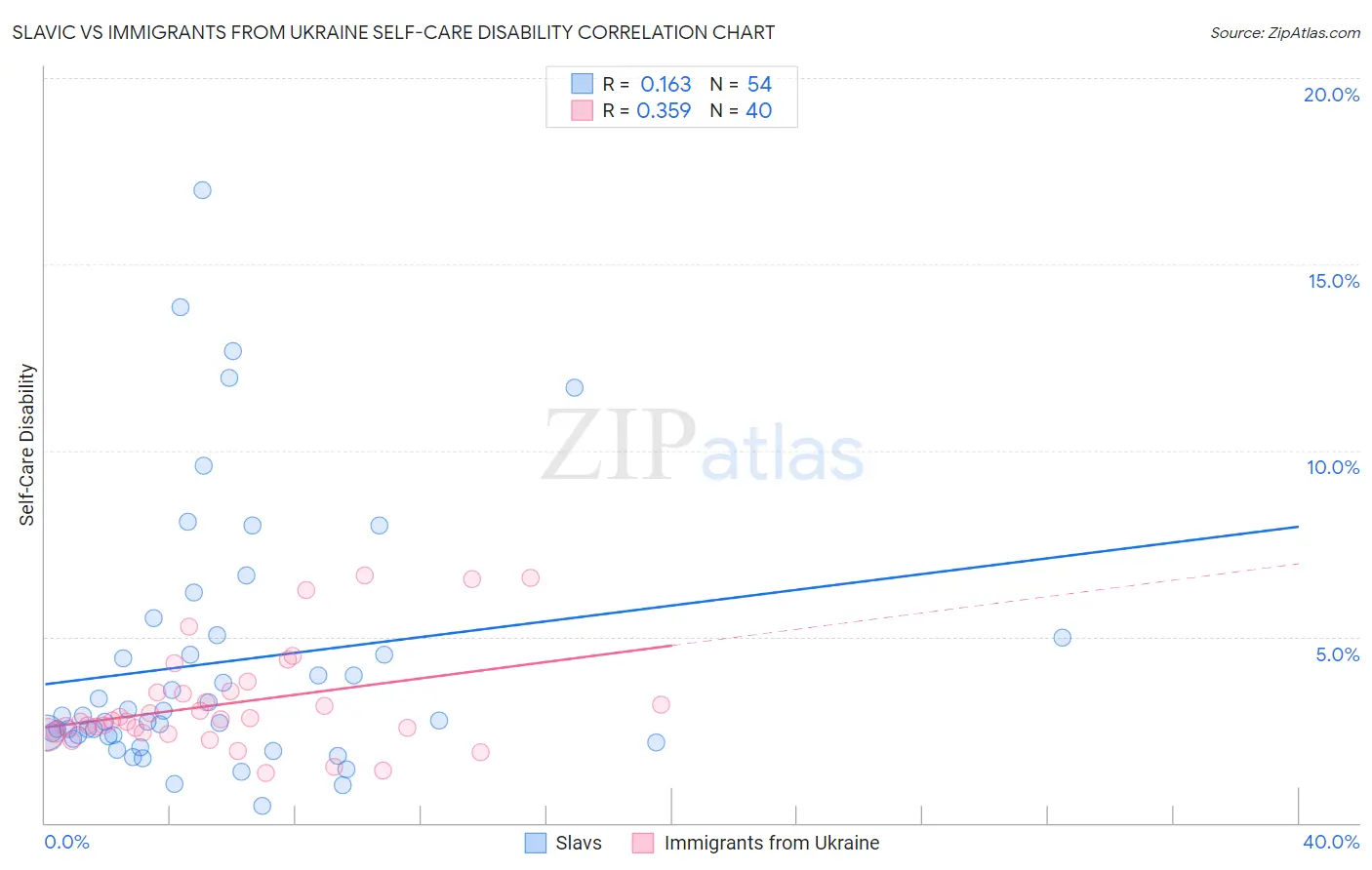Slavic vs Immigrants from Ukraine Self-Care Disability
COMPARE
Slavic
Immigrants from Ukraine
Self-Care Disability
Self-Care Disability Comparison
Slavs
Immigrants from Ukraine
2.5%
SELF-CARE DISABILITY
34.3/ 100
METRIC RATING
185th/ 347
METRIC RANK
2.7%
SELF-CARE DISABILITY
0.1/ 100
METRIC RATING
277th/ 347
METRIC RANK
Slavic vs Immigrants from Ukraine Self-Care Disability Correlation Chart
The statistical analysis conducted on geographies consisting of 270,712,233 people shows a poor positive correlation between the proportion of Slavs and percentage of population with self-care disability in the United States with a correlation coefficient (R) of 0.163 and weighted average of 2.5%. Similarly, the statistical analysis conducted on geographies consisting of 289,474,241 people shows a mild positive correlation between the proportion of Immigrants from Ukraine and percentage of population with self-care disability in the United States with a correlation coefficient (R) of 0.359 and weighted average of 2.7%, a difference of 8.0%.

Self-Care Disability Correlation Summary
| Measurement | Slavic | Immigrants from Ukraine |
| Minimum | 0.47% | 1.3% |
| Maximum | 17.0% | 6.6% |
| Range | 16.5% | 5.3% |
| Mean | 4.3% | 3.2% |
| Median | 2.8% | 2.8% |
| Interquartile 25% (IQ1) | 2.3% | 2.4% |
| Interquartile 75% (IQ3) | 5.0% | 3.5% |
| Interquartile Range (IQR) | 2.6% | 1.1% |
| Standard Deviation (Sample) | 3.6% | 1.4% |
| Standard Deviation (Population) | 3.5% | 1.4% |
Similar Demographics by Self-Care Disability
Demographics Similar to Slavs by Self-Care Disability
In terms of self-care disability, the demographic groups most similar to Slavs are Immigrants from El Salvador (2.5%, a difference of 0.070%), Yugoslavian (2.5%, a difference of 0.090%), Salvadoran (2.5%, a difference of 0.11%), Maltese (2.5%, a difference of 0.16%), and Ghanaian (2.5%, a difference of 0.31%).
| Demographics | Rating | Rank | Self-Care Disability |
| English | 46.2 /100 | #178 | Average 2.5% |
| Hungarians | 45.5 /100 | #179 | Average 2.5% |
| Indonesians | 41.2 /100 | #180 | Average 2.5% |
| Ghanaians | 40.4 /100 | #181 | Average 2.5% |
| Maltese | 37.5 /100 | #182 | Fair 2.5% |
| Salvadorans | 36.4 /100 | #183 | Fair 2.5% |
| Yugoslavians | 36.1 /100 | #184 | Fair 2.5% |
| Slavs | 34.3 /100 | #185 | Fair 2.5% |
| Immigrants | El Salvador | 33.0 /100 | #186 | Fair 2.5% |
| Irish | 28.7 /100 | #187 | Fair 2.5% |
| Immigrants | Oceania | 28.3 /100 | #188 | Fair 2.5% |
| Immigrants | Eastern Europe | 28.0 /100 | #189 | Fair 2.5% |
| Sioux | 24.6 /100 | #190 | Fair 2.5% |
| Moroccans | 22.9 /100 | #191 | Fair 2.5% |
| Soviet Union | 22.2 /100 | #192 | Fair 2.5% |
Demographics Similar to Immigrants from Ukraine by Self-Care Disability
In terms of self-care disability, the demographic groups most similar to Immigrants from Ukraine are Japanese (2.7%, a difference of 0.060%), Ottawa (2.7%, a difference of 0.080%), Iroquois (2.7%, a difference of 0.18%), Yakama (2.7%, a difference of 0.19%), and Immigrants from Trinidad and Tobago (2.7%, a difference of 0.19%).
| Demographics | Rating | Rank | Self-Care Disability |
| Immigrants | Micronesia | 0.1 /100 | #270 | Tragic 2.7% |
| Trinidadians and Tobagonians | 0.1 /100 | #271 | Tragic 2.7% |
| Immigrants | Laos | 0.1 /100 | #272 | Tragic 2.7% |
| Mexicans | 0.1 /100 | #273 | Tragic 2.7% |
| Yakama | 0.1 /100 | #274 | Tragic 2.7% |
| Immigrants | Trinidad and Tobago | 0.1 /100 | #275 | Tragic 2.7% |
| Japanese | 0.1 /100 | #276 | Tragic 2.7% |
| Immigrants | Ukraine | 0.1 /100 | #277 | Tragic 2.7% |
| Ottawa | 0.1 /100 | #278 | Tragic 2.7% |
| Iroquois | 0.1 /100 | #279 | Tragic 2.7% |
| Hispanics or Latinos | 0.1 /100 | #280 | Tragic 2.7% |
| Immigrants | Iraq | 0.0 /100 | #281 | Tragic 2.7% |
| Apache | 0.0 /100 | #282 | Tragic 2.7% |
| Delaware | 0.0 /100 | #283 | Tragic 2.7% |
| Fijians | 0.0 /100 | #284 | Tragic 2.7% |